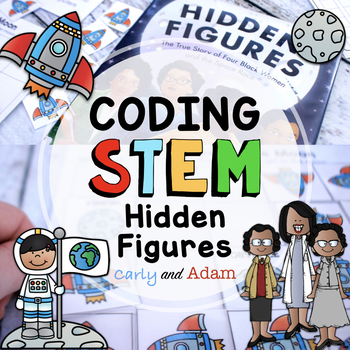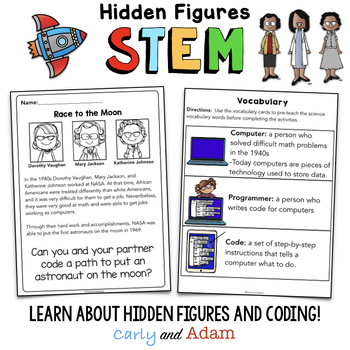Hidden Figures Black History Month Coding Activity
- PDF
- Easel Activity
What educators are saying
Also included in
- Integrate STEM in your classroom during Black History Month with these Read Aloud STEM Challenges! Create a space capsule to bring Apollo astronauts back to earth safely with Katherine JohnsonBuild an air powered rocket shuttle to launch Mae Jemison into spaceInvent something new with Lonnie JohnsonPrice $12.00Original Price $18.00Save $6.00
- Integrate STEM and Literacy in your classroom all year with READ ALOUD STEM Volume One! Everything you need to be the master STEM Teacher at your school! Awaken imagination and creativity all year. Students learn coding, engineering, explore real-world problems, learn about STEM role models, pioneerPrice $100.00Original Price $158.50Save $58.50
Description
Integrate coding in your classroom with an Unplugged Hidden Figures Coding STEM Activity!
Hidden Figures Coding Challenge is a fun and unique way to engage your students during Black History Month and Women's History Month. Teach students that anyone can be a scientist regardless of race or gender.
Students begin the activity by reading about the Hidden Figures. We included our own reading passage, and you can also use Hidden Figures: The True Story of Four Black Women and the Space Race by Margot Lee Shetterly.
Students work together to create different codes to direct the astronauts to the moon. Every activity and solution is unique as students create their own board and code by moving the start point, obstacles, and end points on their coding sheets.
After they have completed their activity, there is time for reflection on what worked and what didn't.
This activity is completely unplugged, and no robots are required. Perfect activity for Hour of Code.
Material List:
- Scissors
- Hidden Figures: The True Story of Four Black Women and the Space Race by Margot Lee Shetterly (Recommended)
Includes:
- Teacher Instructions
- Student Instructions
- Student Coding to the Moon Activity
- Student Reflection Sheet
- Hidden Figures Reading PassageTpT Digital Version for Distance Learning with Google Classroom
Digital Activity:
To use Easel for Distance Learning, select "Open in Easel" on this listing.
Follow us!








